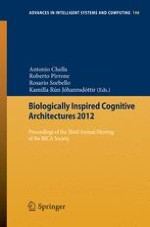2013 | OriginalPaper | Buchkapitel
Architects or Botanists? The Relevance of (Neuronal) Trees to Model Cognition
verfasst von : Giorgio Ascoli
Erschienen in: Biologically Inspired Cognitive Architectures 2012
Verlag: Springer Berlin Heidelberg
Aktivieren Sie unsere intelligente Suche, um passende Fachinhalte oder Patente zu finden.
Wählen Sie Textabschnitte aus um mit Künstlicher Intelligenz passenden Patente zu finden. powered by
Markieren Sie Textabschnitte, um KI-gestützt weitere passende Inhalte zu finden. powered by
The only known cognitive architecture capable of human-level (or rat-level) performance is the human (rat) brain. Why have cognitive architectures equivalent to those instantiated by mammalian brains not been implemented in computers already? Is it just because we have not yet found the right ‘boxes’ to model in our data flow diagrams? Or is there a mysterious reason requiring the underlying hardware to be biologically-based? We surmise that the answer might lie in between: certain essential biological aspects of nervous systems, not (yet) routinely implemented in computational models of cognition, might prove to be necessary functional components. One such aspect is the tree-like structure of neuronal dendrites and axons, the branching inputs and outputs of nerve cells. The basic roles of dendritic and axonal arbors are respectively to integrate synaptic signals from, and to propagate firing patterns to, thousands of other neurons. Synaptic integration and plasticity in dendrites is mediated by their morphology and biophysics. Axons provide the vast majority of cable length, constituting the main determinant of network connectivity. Together, neuronal computation and circuitry provide the substrates for the activity dynamics instantiating cognitive function.
An additional consequence of the tree-shape of neurons is far less recognized. Axons and dendrites determine not only which neurons are connected to which, and thus the possible activation patterns (mental states), but also which new connections might form given the right experience. Specifically, new synapses can only form between axons and dendrites that are in close proximity. This fundamental constraint may constitute the neural correlate of the common observation that knowledge of appropriate background information is necessary for memory formation. Specifically, neurons that are near each other (in connectivity space) encode related information. This biologically inspired design feature also enables cognitive architectures (e.g. neural networks) to learn real associations better than spurious co-occurrences, resulting in greater performance and enhanced robustness to noise.
